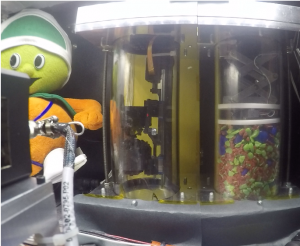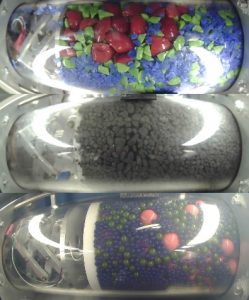Why investigate regolith?
Regolith is the layer of crushed up rock and/or organic material covering bedrock on rocky planets. “Soil” is a special case of regolith where there is organic matter (decaying plants, etc.) and soil is only found on Earth (so far). Understanding regolith may help us to utilize the resources (elements, compounds) within the regolith. If we travel to the moon or other objects covered with regolith, we may be able to generate products with local resources.
In the 1960’s and 1970’s, NASA launched their Apollo missions with the goal of landing humans on and exploring the Moon. Apollo 11 was the first human landing on the surface of the Moon in 1969. After Apollo 11, the Apollo 12, 14, 15, 16, and 17 landed in various regions on the lunar surface. Early missions tended to land in the relatively flat, dark areas of the Moon known as the lunar mare (Latin for “ocean”). Apollo 16 and 17 were more focused on the more mountainous, lighter colored parts of the Moon known as the lunar highlands. The lunar highlands and lunar mare are made of different materials, and have different properties and behave differently when walked on, driven on, and so on. Therefore, it is necessary to know how these different materials behave in low gravity when performing various scientific experiments or engineering activities. See this infographic about regolith developed by Teacher-in-Residence Danielle Miller.
Strata-2P is a technology development payload intended to test sensors in reduced (lunar) gravity aboard a parabolic aircraft. These sensors are intended to help determine properties of the lunar regolith (soil on the Moon). This will in turn help NASA’s science and exploration activities during the coming decade with the Artemis program. By testing our sensors and hardware in this way aboard the aircraft, we can fix issues that arise in low-gravity that we cannot study on Earth (because everything on the Earth is in 1-g, 1 gravity). We hope to mature this hardware for future NASA missions to the Moon.
The science goals of the Strata-2P project are to determine certain particle and bulk regolith properties under reduced gravity and under vacuum (i.e., space-like environment). Properties of soil, like its thermoelectric properties, bulk bearing (sheer) strength, along with how it size-sorts or its “stratigraphies” (hence the name Strata) are studied.

Our experiment
The thermal conductivity experiments of Strata-2P were made to test how quickly heat transfers through simulated highlands and simulated mare regolith. Heaters were put in the tubes with temperature sensors, and the heaters were activated when in low gravity to see how different amounts of gravity affects heat transfer. The electrical conductivity experiments in Strata-2P were made to test how well the simulated highlands and mare regolith conduct electricity and how that conductivity changes with gravity. The teacher tubes were filmed so that students could analyze the motion and interaction of particles during the changing gravity environments provided during the flight.
An entrapulator is a device invented by the Strata-2P team to compress the regolith simulants in the tubes. The amount of compression/compaction affects how strong the regolith is (how hard it is to push a sharp object into), as well as how well heat and electricity are transferred through the simulant. Being able to study strength, thermal conductivity, and electrical conductivity in different levels of compression and in different levels of gravity is very important to NASA and others around the world, so the entrapulator is a key part of the Strata-2P experiments.
The Strata-2P Penetrometer probes are intended to mimic geologic soil penetrometers on the Earth and are specially outfitted for robotic use on the Moon. These devices use a force sensor (strain gauge) in line with a cone-shaped metal tip that pierces the compacted regolith. A motor pushes the probe into a column of simulated lunar regolith simulant and the sensor measures the force throughout the process. We will analyze this data to determine the varying strengths of lunar dust under lunar gravity for different compaction levels (volumetric densities) and types of regolith (lunar highlands anorthositic and lunar Mare basaltic based soils). This data will help with building structures on the Moon, drilling or digging into the lunar soil, and mining for precious resources like water on the Moon.
3D design was used to model and design the rack that the experiments were mounted on during the low-gravity flights. This way, the Strata-2P team could use computer software to know how to build the rack without having to build many different versions and hope all the parts fit together correctly. 3D printing was used to make the mounts that hold the temperature sensors and electricity sensors in place within the experiment tubes during flight. Without these, the data would have been less reliable and trustworthy. See this infographic of an overview of Strata-2P developed by Teacher-in-Residence Danielle Miller.

Data
The Strata-2P team collected data on time vs. acceleration (gravity), time vs. temperature of the heaters and sensors in the thermal conductivity tubes, as well as time vs. voltage for the electrical conductivity experiment tubes.
Looking for patterns in the data
Data analyses follow established standard methods. These standard methods make sure that researchers all around the world use the same types of methods so that results are directly comparable. The thermal conductivity analysis takes the time vs. temperature data and figures out the thermal conductivity of the regolith simulant (in other words, how fast does the heat transfer through the material). The electrical conductivity analysis take voltage vs. time data to see how much the output voltage changes with gravity throughout the flight with a constant applied voltage.
What we’ve learned so far
Findings coming later in 2023 …
